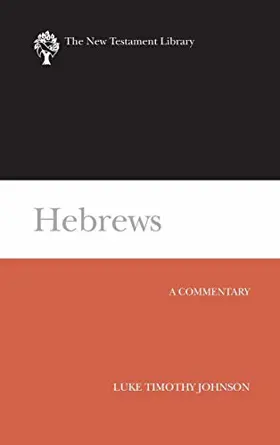

Hebrews
Pages
432
Publisher
Westminster John Knox
Published
1/1/2006
ISBN-13
9780664221188
Collections
This book appears in the following featured collections.
- Favorite Advanced NT Commentaries by Jeremy Pierce (parableman)
- Ultimate Commentary Collection: NT Technical by John Glynn
- The Pastor’s Bookshelf by Scot McKnight
- New Testament Commentaries & Monographs by Princeton Theological Seminary
- Nijay Gupta's Top NT Commentaries by Nijay K. Gupta
- Recommended New Testament Commentaries for Evangelical Pastors by Thomas R. Schreiner
- Commentaries by Roman Catholic Scholars by John Dyer
Reviews
I have become a collector of commentaries ever since my seminary days in the 1990s. As such, I am only going to recommend the best overall commentary for each book of the Bible on this site. In one's study of Hebrews, Johnson's work is where I would recommend starting. It sides at times more on the academic side of the proverbial aisle, but that often proves helpful through a biblical book like Hebrews.
Read the introduction, and you will be hooked.
This is my preferred commentary on Hebrews. The OTL/NTL series has a reputation for being more high criticism focused. This is true of the older volumes, but many of the more recent releases are quite good. Johnson is a scholar of the highest caliber, and this commentary is Johnson at his best. I haven't done much with Hebrews, but this commentary is definitely the first one I go to.
University of the Saarland Saarbrücken, Germany Die Auslegung von L. T. Johnson geht nach einer ausführlichen Einleitung (1–60) eng am Text des Hebr entlang: Nach einer kurzen Einführung in den Textabschnitt folgt jeweils eine Übersetzung des griechischen Textes mit textkritischen Anmerkungen. Anschließend bietet Johnson eine versweise Auslegung, die vor allem auf die theologischen Inhalte abhebt. Die Diskussion mit Sekundärliteratur findet statt, jedoch in einem nicht allzu zu breiten Rahmen. Eingefügt sind sieben Exkurse zu den Themen: Engel, die Wüste als Paradigma, Leiden und Glaubensgehorsam, Melchisedek, Alter und Neuer Bund, Heiligtum, Lob der Väter Israels. Mögliche thematische und rhetorische Gliederungen des Hebr diskutiert Johson zwar (9–14), legt in der Kommentierung aber keine solche thematische oder rhetorische Gliederung zugrunde, sondern analysiert nacheinander 27 Perikopen. Unter rhetorischen Gesichtspunkten gehört der Hebr nach Johnson zur „deliberative rhetoric with epideictic features“ (13). Dabei sei seine hochstehende, gewählte Sprache reich an Metaphern. Der Autor appelliere sowohl an die ratio wie auch die emotio. Seine Struktur sei durchgehend geprägt durch den Wechsel von Auslegung (exposition) und Ermahnung (exhortation) (15).
[Full Review]
This commentary is a welcome contribution to recent literature on Hebrews. Substantial in content and readable in form, it will help a wide range of readers appreciate the message and artistry of this challenging New Testament book. The opening lines of Johnson’s introduction strike an important tone, pointing out that the unnamed author of Hebrews summons people to a vision of reality and a committed faith that is at once distinctive, attractive, and disturbing. In the pages of Hebrews, modern readers find a world that is very different from the one that is familiar to them. It is a world in which the unseen is more real and attractive than that which can be seen and touched. “In a word, Hebrews proposes as real a world that most of us consider imaginary” (2). Moreover, Hebrews stretches readers’ perspectives with a Christology that is replete with tensions between Jesus’ humanity and divinity, his crucifixion and exaltation. In the portrayal of Christ as high priest, the author invokes notions of sacrifice that will seem alien to many people today. To follow the Christ depicted in Hebrews means embarking on a course that requires endurance and a willingness to suffer for the sake of the faith. Entering into full maturity as God’s children means being transformed by the suffering that comes from obedience, following the path of Jesus.
[Full Review]





